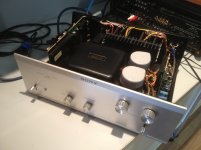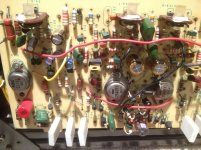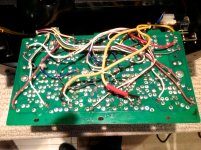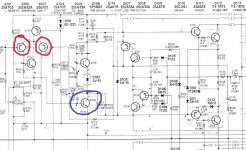Hello All,
Before and after a full Electrolytic recap I am still getting a crackling noise much like the sound of a dirty vinyl record. It comes on after about 5 minutes from power up and last for about the same time then disappears. It is independent of the volume control which has no effect on the noise.
I have checked all the solder joints through out the amp board and power supply which seem fine, I have removed all the out put transistors and cleaned the contact and put new thermal pad on. I am now thinking component failure. There are a number of those nice old brown carbon resistors on the amp board
(none of the resistors look burnt - generally this amp is in good condition). My thought is to just replace them. If this were a transistor issue would the amp just fail? I am also assuming that the issue is very likely on the amp board and not power supply. All controls are clean.
Any thoughts and help I can get as to where I should go from here is most welcome. Images attached for reference.
Also the Offset is 0V DC both channels and Bias is 25mv per channel as per the service manual. All measurements stable.
Cheers,
Clive I think this should be in the DIY section, but not sure how to move it.
Before and after a full Electrolytic recap I am still getting a crackling noise much like the sound of a dirty vinyl record. It comes on after about 5 minutes from power up and last for about the same time then disappears. It is independent of the volume control which has no effect on the noise.
I have checked all the solder joints through out the amp board and power supply which seem fine, I have removed all the out put transistors and cleaned the contact and put new thermal pad on. I am now thinking component failure. There are a number of those nice old brown carbon resistors on the amp board
(none of the resistors look burnt - generally this amp is in good condition). My thought is to just replace them. If this were a transistor issue would the amp just fail? I am also assuming that the issue is very likely on the amp board and not power supply. All controls are clean.
Any thoughts and help I can get as to where I should go from here is most welcome. Images attached for reference.
Also the Offset is 0V DC both channels and Bias is 25mv per channel as per the service manual. All measurements stable.
Cheers,
Clive I think this should be in the DIY section, but not sure how to move it.
Attachments
Last edited:
If the noise is coming from both channels,look for bad frame metal to pcb ground screws loose. Many of the older Sony's relied on solder pads contacting the metal frame for circuit grounding. Most of the time you can just tighten the screw to improve the connection. If the noise is from just one channel at a time,chances are you have leaky transistors in the differential. 2SA705. The 2SA706's should be replaced as well.
You could try the KSA992F for the 2SA705. Mouser--->KSA992FBU Fairchild Semiconductor | Mouser or MCM --->Denon Electronics Original Transistor | 9600196205 | Denon Electronics or you could use a 2SA953 from B&D ---->2SA953 - B&D Enterprises International.
Just make sure you watch your pinouts;ie ECB vs. CBE. I don't recall the 705 or 6 being cbe but I could be wrong.
You could try the 2SA1241 from B&D --->2SA1241 - B&D Enterprises International for the 2SA706.
Just make sure you watch your pinouts;ie ECB vs. CBE. I don't recall the 705 or 6 being cbe but I could be wrong.
You could try the 2SA1241 from B&D --->2SA1241 - B&D Enterprises International for the 2SA706.
Is the problem on both channels ? That's a big clue.
If it is both then check things like the mains switch (arcing), fuse holders, plug top wiring etc. Don't assume anything is good unless checked.
If its one channel then suspects would include tantalum caps, compressed disc ceramic caps and semiconductors. For inexplicable reasons, Japanese semiconductors of the type often used for drivers etc. (in other words medium power devices) often fail intermittently, sometimes noisy in the way you describe.
If it is both then check things like the mains switch (arcing), fuse holders, plug top wiring etc. Don't assume anything is good unless checked.
If its one channel then suspects would include tantalum caps, compressed disc ceramic caps and semiconductors. For inexplicable reasons, Japanese semiconductors of the type often used for drivers etc. (in other words medium power devices) often fail intermittently, sometimes noisy in the way you describe.
Is the problem on both channels ? That's a big clue.
If it is both then check things like the mains switch (arcing), fuse holders, plug top wiring etc. Don't assume anything is good unless checked.
If its one channel then suspects would include tantalum caps, compressed disc ceramic caps and semiconductors. For inexplicable reasons, Japanese semiconductors of the type often used for drivers etc. (in other words medium power devices) often fail intermittently, sometimes noisy in the way you describe.
Left Channel only. There is a tantalum cap in the photo ( the one at the top that looks like a small orange ball ) that appears to have burn marks where the leads go into the board. Think that means anything?
You could try the KSA992F for the 2SA705. Mouser--->KSA992FBU Fairchild Semiconductor | Mouser or MCM --->Denon Electronics Original Transistor | 9600196205 | Denon Electronics or you could use a 2SA953 from B&D ---->2SA953 - B&D Enterprises International.
Just make sure you watch your pinouts;ie ECB vs. CBE. I don't recall the 705 or 6 being cbe but I could be wrong.
You could try the 2SA1241 from B&D --->2SA1241 - B&D Enterprises International for the 2SA706.
Thanks pdleman, I will keep this info if it indeed turns out to be the trannies.
Tants are favourite failure items. They often go noisy and leaky or even short. Just pop and ordinary electro in its place.
Mooly Would I need to put in an Electrolytic Bi Polar? If not where would I put the neg lead?
You should be able to tell from the circuit but if not just measure the voltage across it with the amp on and fit accordingly. Just fit an ordinary cap of suitable voltage.
Is that a carbon composition resistor lurking around there too ?
There are a number of carbon resistors in there. When I get this noise issue settled I am going to replace them.
There are a number of carbon resistors in there. When I get this noise issue settled I am going to replace them.
The noise issue could possibly be a carbon comp playing up
The noise issue could possibly be a carbon comp playing up
mmm, but it also could be a transistor, no? Where to start Mooly? Yanking the resistors and a few tants are easy and probably should be done anyway. Would this be your first approach? I have taken voltage readings across most of the transistors that I can get my probes into and they seems to be no shorts, they are all reading voltage.
Well, everyone keeps saying it could be the front end transistors so that has to be considered... they could be a type prone to this kind of failure... it happens. So perhaps do as others suggest and swap them over to prove.
Where would I start... replacing any tants simply because they are notoriously unreliable. Carbon comps are in the same category really. There is no really scientific way to prove where the fault is... a scope could be a good guide but not definitive for this kind of problem. Go for the most likely suspects first. That tant for one and perhaps the diff transistors as everyone seems to know something I don't about those
Where would I start... replacing any tants simply because they are notoriously unreliable. Carbon comps are in the same category really. There is no really scientific way to prove where the fault is... a scope could be a good guide but not definitive for this kind of problem. Go for the most likely suspects first. That tant for one and perhaps the diff transistors as everyone seems to know something I don't about those
Silly question I am sure, but which ones are those?Input diff pair transistors are the usual culprit.
Try swapping these transistors from channel to channel.
While you are at it, inspect these transistors for black legs....this is a usual sure sign of noisy transistors.
Regards, Dan.
Do we have a circuit for this amp ?
The differential amp transistors will be the first "pair" with the emitters connected (or closely connected) together. Those metal tabbed driver types would be my suspects but none of this is helping is it
Be methodical, and it should take very little time to pin the fault down. Ultimately anything could be causing the problem but in practice it will be one of the "usual" suspects. Old preset pots can go intermittent too, not just the wiper but the rivets that secure the leadouts to the carbon track.
The differential amp transistors will be the first "pair" with the emitters connected (or closely connected) together. Those metal tabbed driver types would be my suspects but none of this is helping is it
Be methodical, and it should take very little time to pin the fault down. Ultimately anything could be causing the problem but in practice it will be one of the "usual" suspects. Old preset pots can go intermittent too, not just the wiper but the rivets that secure the leadouts to the carbon track.
The ones in red are the differential amp. The one in blue (the VAS or voltage amplifier stage) would be a suspect purely on the grounds that it runs hot (ish) continually and would be suspect for that reason and the type of device it is. That's very unscientific I know, just experience points the finger 
Attachments
- Status
- This old topic is closed. If you want to reopen this topic, contact a moderator using the "Report Post" button.
- Home
- Amplifiers
- Solid State
- Sony TA3200f Issue



